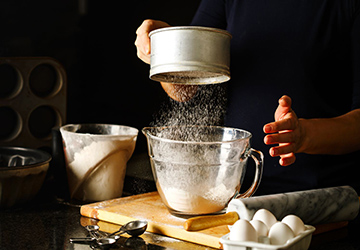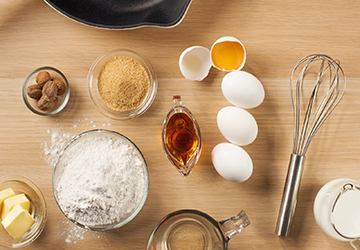The rise of gluten-free diets and the increasing awareness of Celiac disease have paved the way for a new era in baking – one that embraces both health and taste. Gone are the days when baking without wheat meant compromising flavor or texture. Welcome to the modern kitchen, where gluten-free recipes and alternative flours reign supreme. In this article, we'll explore the nuances of Celiac-friendly baking, introduce you to the world of wheat-free desserts, and delve into the plethora of alternative flours available.

Consuming gluten-containing products can lead to serious health complications for those diagnosed with Celiac disease or gluten sensitivity. Therefore, it's vital to ensure that baked goods are not just wheat-free but entirely devoid of gluten. Embracing gluten-free recipes ensures a safer and healthier diet for those affected.
Modern bakers are turning their kitchens into experimental labs, trying and testing gluten-free recipes to achieve the perfect taste and texture. Thanks to advancements in culinary science and a broader understanding of ingredients, Celiac-friendly baking is no longer a challenge but an exciting journey.
Who said that going gluten-free means giving up on indulgent treats? Wheat-free desserts have come a long way, with pastries, cakes, and cookies that are just as delicious, if not more so, than their wheat-based counterparts. Brownie bites made with almond flour, lemon drizzle cakes with coconut flour, or even macarons using chickpea water (aquafaba) are just a glimpse of the world of delectable wheat-free desserts.
The spotlight on gluten-free recipes has brought forth a range of alternative flours. Let's explore some popular ones:
● Almond Flour: A favorite for many due to its moist texture and rich, nutty flavor. Perfect for cookies, cakes, and even pancakes.
● Coconut Flour: Highly absorbent and perfect for those who love a mild coconut flavor in their baked goods.
● Rice Flour: Neutral in taste and versatile, rice flour can be a base in various baked goods.
● Buckwheat Flour: Despite its name, buckwheat is entirely gluten-free. It gives a rich, earthy flavor and works wonders in pancakes and bread.
● Tapioca Flour: Often used with other flours, it helps achieve a chewy texture in baked goods.
● Experiment with Flours:
● Achieving the right crumb or chewiness can be a challenge. A blend of alternative flours can bring you closer to that familiar wheat texture.
Each alternative flour behaves differently, so experiment with each type and find what combinations work best for you.
● Stay Hydrated: Gluten-free flours often require more moisture. Ensure your batter or dough isn't too dry.
● Xanthan Gum & Guar Gum: Gluten provides structure and elasticity to baked goods. Other binders like xanthan gum, flaxseed gel, or psyllium husk can be used without it.
These binding agents have a vital role in gluten-free recipes. They help in achieving the desired consistency in the absence of gluten.
● Read Labels: Especially when baking for those with Celiac disease. Cross-contamination is a genuine concern, so always buy certified gluten-free ingredients.
● Aeration: Gluten helps trap air, which results in fluffy bread. Egg whites, carbonated water, or even vinegar can help mimic this in gluten-free recipes.
The science behind gluten-free recipes is easy to understand. Insight into the role gluten plays can help in mastering the art of gluten-free recipes.

The world is brimming with culinary wonders, many of which are naturally gluten-free or can be adapted easily:
● Latin America: Think of the classic Argentinian empanada made with corn flour or the Brazilian cheese bread, "pão de queijo," delightfully chewy and entirely gluten-free.
● Asia: Rice is the staple grain in many Asian cuisines. Delights like Thai sticky rice desserts or Vietnamese paper rolls are naturally gluten-free.
● Africa: The Ethiopian "injera," a sourdough flatbread, is traditionally made from teff flour, a nutritious and gluten-free grain.
Gluten-free recipes often yield products with a different shelf life than regular baked goods:
● Moisture Retention: Some gluten-free baked goods tend to dry out faster. Consider storing them in airtight containers or using natural humectants like honey or agave to retain moisture.
● Freezing: Many Celiac-friendly baking items freeze well. It can be beneficial to bake in batches and then defrost as needed.
While baking at home offers control, eating out can be tricky:
● Research Ahead: Look for restaurants with Celiac-friendly baking options or dedicated gluten-free menus.
● Communication: Always inform the staff about your gluten intolerance or Celiac disease, emphasizing the importance of avoiding cross-contamination.
Like all culinary arts, gluten-free baking has its challenges:
● Cost: Alternative flours and gluten-free ingredients can be pricier. Buying in bulk or sourcing locally might help reduce expenses.
● Availability: Not all regions have easy access to specialized ingredients. Consider online retailers or international food sections in larger supermarkets.
● Taste Variation: Using alternative flours can sometimes produce a distinct flavor. You can achieve a taste you like by experimenting with blends and ratios.
As the trend for gluten-free recipes grows, communities worldwide are sharing their Celiac-friendly baking experiences. Engaging in these groups can provide fresh insights into wheat-free desserts and the best practices with alternative flour. Embracing this collective wisdom can elevate your baking journey to new heights.
With the wealth of alternative flour and the ever-evolving world of Celiac-friendly baking, there's no reason anyone should miss out on the joys of baked goods. Gluten-free recipes are more than just a trend; they're a testament to the culinary world's adaptability and inclusivity. Embrace the art of gluten-free baking and revel in the delicious possibilities of the modern kitchen.
Note: Please ensure that all ingredients used in recipes are truly gluten-free. Even trace amounts of gluten can cause reactions in those with Celiac disease or severe gluten sensitivities. Always prioritize health and safety.